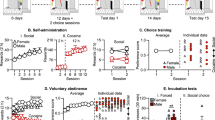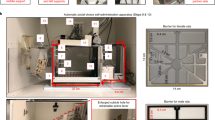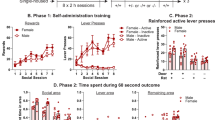Abstract
Social interactions are rewarding and protective against substance use disorders, but it is unclear which specific aspect of the complex sensory social experience drives these effects. Here, we investigated the role of olfactory sensory experience on social interaction, social preference over cocaine, and cocaine craving in rats. First, we conducted bulbectomy on both male and female rats to evaluate the necessity of olfactory system experience on the acquisition and maintenance of volitional social interaction. Next, we assessed the effect of bulbectomy on rats given a choice between social interaction and cocaine. Finally, we evaluated the influence of olfactory sensory experience by training rats on volitional partner-associated odors, assessing their preference for partner odors over cocaine to achieve voluntary abstinence and assessing its effect on the incubation of cocaine craving. Bulbectomy impaired operant social interaction without affecting food and cocaine self-administration. Rats with intact olfactory systems preferred social interaction over cocaine, while rats with impaired olfactory sense showed a preference for cocaine. Providing access to a partner odor in a choice procedure led to cocaine abstinence, preventing incubation of cocaine craving, in contrast to forced abstinence or non-contingent exposure to cocaine and partner odors. Our data suggests the olfactory sensory experience is necessary and sufficient for volitional social reward. Furthermore, the active preference for partner odors over cocaine buffers drug craving. Based on these findings, translational research should explore the use of social sensory-based treatments utilizing odor-focused foundations for individuals with substance use disorders.
This is a preview of subscription content, access via your institution
Access options
Subscribe to this journal
Receive 13 print issues and online access
$259.00 per year
only $19.92 per issue
Buy this article
- Purchase on Springer Link
- Instant access to full article PDF
Prices may be subject to local taxes which are calculated during checkout





Similar content being viewed by others
References
Galef BG. Animal communication: sniffing is about more than just smell. Curr Biol. 2013;23:272–73.
Diamond ME, Arabzadeh E. Whisker sensory system - from receptor to decision. Prog Neurobiol. 2013;103:28–40.
Ravreby I, Snitz K, Sobel N. There is chemistry in social chemistry. Sci Adv. 2022;8:eabn0154.
Gaby JM, Zayas V. Smelling is telling: human olfactory cues influence social judgments in semi-realistic interactions. Chem Senses. 2017;42:405–18.
Boesveldt S, Parma V. The importance of the olfactory system in human well-being, through nutrition and social behavior. Cell Tissue Res. 2021;383:559–67.
Sela L, Sobel N. Human olfaction: a constant state of change-blindness. Exp Brain Res. 2010;205:13–29.
Zelano C, Sobel N. Humans as an animal model for systems-level organization of olfaction. Neuron. 2005;48:431–54.
Roberts SC, Havlicek J, Schaal B. Human olfactory communication: current challenges and future prospects. Philos Trans R Soc Lond B Biol Sci. 2020;375:20190258.
Popik P, Vetulani J, Bisaga A, van Ree JM. Recognition cue in the rat’s social memory paradigm. J Basic Clin Physiol Pharm. 1991;2:315–27.
Pena RR, Medeiros DC, Guarnieri LO, Guerra JB, Carvalho VR, Mendes E, et al. Home-cage odors spatial cues elicit theta phase/gamma amplitude coupling between olfactory bulb and dorsal hippocampus. Neuroscience. 2017;363:97–106.
Contestabile A, Casarotto G, Girard B, Tzanoulinou S, Bellone C. Deconstructing the contribution of sensory cues in social approach. Eur J Neurosci. 2021;53:3199–211.
Gerber N, Schweinfurth MK, Taborsky M. The smell of cooperation: rats increase helpful behaviour when receiving odour cues of a conspecific performing a cooperative task. Proc Biol Sci. 2020;287:20202327.
Lin DY, Zhang SZ, Block E, Katz LC. Encoding social signals in the mouse main olfactory bulb. Nature. 2005;434:470–7.
Herz RS. Odor-associative learning and emotion: effects on perception and behavior. Chem Senses. 2005;30:i250–1.
Prakash N, Matos HY, Sebaoui S, Tsai L, Tran T, Aromolaran A, et al. Connectivity and molecular profiles of Foxp2- and Dbx1-lineage neurons in the accessory olfactory bulb and medial amygdala. J Comp Neurol. 2023.
Herz RS. A naturalistic analysis of autobiographical memories triggered by olfactory visual and auditory stimuli. Chem Senses. 2004;29:217–24. https://doi.org/10.1002/cne.25545.
Leschak CJ, Eisenberger NI. The role of social relationships in the link between olfactory dysfunction and mortality. PLoS One. 2018;13:e0196708.
Moberg PJ, Agrin R, Gur RE, Gur RC, Turetsky BI, Doty RL. Olfactory dysfunction in schizophrenia: a qualitative and quantitative review. Neuropsychopharmacology. 1999;21:325–40.
Guay S, Nachar N, Lavoie ME, Marchand A, O’Connor KP. The buffering power of overt socially supportive and unsupportive behaviors from the significant other on posttraumatic stress disorder individuals’ emotional state. Anxiety Stress Coping. 2017;30:52–65.
Hamaideh S, Al-Magaireh D, Abu-Farsakh B, Al-Omari H. Quality of life, social support, and severity of psychiatric symptoms in Jordanian patients with schizophrenia. J Psychiatr Ment Health Nurs. 2014;21:455–65.
Mahmut M, Stevenson R. Olfactory abilities and psychopathy: higher psychopathy scores are associated with poorer odor discrimination and identification. Chem Percept. 2012;5:300–07.
Mishor E, Amir D, Weiss T, Honigstein D, Weissbrod A, Livne E, et al. Sniffing the human body volatile hexadecanal blocks aggression in men but triggers aggression in women. Sci Adv. 2021;7:eabg1530.
Squires S, Chichester C, Cirelli D, Divadio L, Hulcher S. Sensory alterations in alcohol abuse. Top Clin Nurs. 1985;6:51–63.
Schafer L, Schriever VA, Croy I. Human olfactory dysfunction: causes and consequences. Cell Tissue Res. 2021;383:569–79.
Papazian EJ, Pinto JM. Olfactory loss and aging: connections with health and well-being. Chem Senses. 2021;46:bjab045.
Agarwal K, Luk JW, Manza P, McDuffie C, To L, Jaime-Lara RB, et al. Chemosensory alterations and impact on quality of life in persistent alcohol drinkers. Alcohol Alcohol. 2023;58:84–92.
Sayette MA, Marchetti MA, Herz RS, Martin LM, Bowdring MA. Pleasant olfactory cues can reduce cigarette craving. J Abnorm Psychol. 2019;128:327–40.
Klein B, Bautze V, Maier AM, Deussing J, Breer H, Strotmann J. Activation of the mouse odorant receptor 37 subsystem coincides with a reduction of novel environment-induced activity within the paraventricular nucleus of the hypothalamus. Eur J Neurosci. 2015;41:793–801.
Niu H, Zheng Y, Rizak JD, Fan Y, Huang W, Ma Y, et al. The effects of lesion of the olfactory epithelium on morphine-induced sensitization and conditioned place preference in mice. Behav Brain Res. 2012;233:71–8.
Venniro M, Zhang M, Caprioli D, Hoots JK, Golden SA, Heins C, et al. Volitional social interaction prevents drug addiction in rat models. Nat Neurosci. 2018;21:1520–29.
Venniro M, Russell TI, Zhang M, Shaham Y. Operant social reward decreases incubation of heroin craving in male and female rats. Biol Psychiatry. 2019;86:848–56.
Venniro M, Russell TI, Ramsey LA, Richie CT, Lesscher HMB, Giovanetti SM, et al. Abstinence-dependent dissociable central amygdala microcircuits control drug craving. Proc Natl Acad Sci USA. 2020;117:8126–34.
Venniro M, Panlilio LV, Epstein DH, Shaham Y. The protective effect of operant social reward on cocaine self-administration, choice, and relapse is dependent on delay and effort for the social reward. Neuropsychopharmacology. 2021;46:2350–57.
Venniro M, Shaham Y. An operant social self-administration and choice model in rats. Nat Protoc. 2020;15:1542–59.
Ramsey LA, Holloman FM, Hope BT, Shaham Y, Venniro M. Waving through the window: a model of volitional social interaction in female mice. Biol Psychiatry. 2022;91:988–97.
Ramsey LA, Holloman FM, Lee SS, Venniro M. An operant social self-administration and choice model in mice. Nat Protoc. 2023;18:1669–86.
Ahmed SH. Validation crisis in animal models of drug addiction: beyond non-disordered drug use toward drug addiction. Neurosci Biobehav Rev. 2010;35:172–84.
Lenoir M, Serre F, Cantin L, Ahmed SH. Intense sweetness surpasses cocaine reward. PLoS One. 2007;2:e698.
Venniro M, Marino RAM, Chow JJ, Caprioli D, Epstein DH, Ramsey LA, et al. The protective effect of social reward on opioid and psychostimulant reward and relapse: behavior, pharmacology, and brain regions. J Neurosci. 2022;42:9298–314.
Venniro M, Reverte I, Ramsey LA, Papastrat KM, D’Ottavio G, Milella MS, et al. Factors modulating the incubation of drug and non-drug craving and their clinical implications. Neurosci Biobehav Rev. 2021;131:847–64.
Fredriksson I, Venniro M, Reiner DJ, Chow JJ, Bossert JM, Shaham Y. Animal models of drug relapse and craving after voluntary abstinence: a review. Pharm Rev. 2021;73:1050–83.
de Waal FBM, Preston SD. Mammalian empathy: behavioural manifestations and neural basis. Nat Rev Neurosci. 2017;18:498–509.
Chadman KK, Yang M, Crawley JN. Criteria for validating mouse models of psychiatric diseases. Am J Med Genet B Neuropsychiatr Genet. 2009;150B:1–11.
Venniro M, Banks ML, Heilig M, Epstein DH, Shaham Y. Improving translation of animal models of addiction and relapse by reverse translation. Nat Rev Neurosci. 2020;21:625–43.
Robinson TE, Berridge KC. The neural basis of drug craving: an incentive-sensitization theory of addiction. Brain Res Brain Res Rev. 1993;18:247–91.
Edwards DA, Thompson ML, Burge KG. Olfactory bulb removal vs peripherally induced anosmia: differential effects on the aggressive behavior of male mice. Behav Biol. 1972;7:823–8.
Li Q, Takeuchi Y, Wang J, Gellert L, Barcsai L, Pedraza LK, et al. Reinstating olfactory bulb-derived limbic gamma oscillations alleviates depression-like behavioral deficits in rodents. Neuron 2023;111:2065–75.e5.
Leinders-Zufall T, Lane AP, Puche AC, Ma W, Novotny MV, Shipley MT, et al. Ultrasensitive pheromone detection by mammalian vomeronasal neurons. Nature. 2000;405:792–6.
Albrechet-Souza L, Gilpin NW. The predator odor avoidance model of post-traumatic stress disorder in rats. Behav Pharm. 2019;30:105–14.
Verbitsky A, Dopfel D, Zhang N. Rodent models of post-traumatic stress disorder: behavioral assessment. Transl Psychiatry. 2020;10:132.
Caprioli D, Venniro M, Zeric T, Li X, Adhikary S, Madangopal R, et al. Effect of the novel positive allosteric modulator of metabotropic glutamate receptor 2 azd8529 on incubation of methamphetamine craving after prolonged voluntary abstinence in a rat model. Biol Psychiatry. 2015;78:463–73.
Caprioli D, Venniro M, Zhang M, Bossert JM, Warren BL, Hope BT, et al. Role of dorsomedial striatum neuronal ensembles in incubation of methamphetamine craving after voluntary abstinence. J Neurosci. 2017;37:1014–27.
Venniro M, Zhang M, Shaham Y, Caprioli D. Incubation of methamphetamine but not heroin craving after voluntary abstinence in male and female rats. Neuropsychopharmacology. 2017;42:1126–35.
Aklin WM, Wong CJ, Hampton J, Svikis DS, Stitzer ML, Bigelow GE, et al. A therapeutic workplace for the long-term treatment of drug addiction and unemployment: eight-year outcomes of a social business intervention. J Subst Abus Treat. 2014;47:329–38.
Silverman K, DeFulio A, Sigurdsson SO. Maintenance of reinforcement to address the chronic nature of drug addiction. Prev Med. 2012;55:S46–53.
Azrin NH. Improvements in the community-reinforcement approach to alcoholism. Behav Res Ther. 1976;14:339–48.
Stitzer ML, Jones HE, Tuten M, Wong C. Community reinforcement approach and contingency management interventions for substance abuse. In W M Cox, E Klinger, editors. Handbook of Motivational Counseling: Goal-Based Approaches to Assessment and Intervention with Addiction and Other Problems. Chichester, UK: John Wiley & Sons, Ltd; 2011.
Lash SJ, Burden JL, Monteleone BR, Lehmann LP. Social reinforcement of substance abuse treatment aftercare participation: Impact on outcome. Addict Behav. 2004;29:337–42.
Masuo Y, Satou T, Takemoto H, Koike K. Smell and stress response in the brain: review of the connection between chemistry and neuropharmacology. Molecules. 2021;26:2571.
Spence C. The scent of attraction and the smell of success: crossmodal influences on person perception. Cogn Res Princ Implic. 2021;6:46.
Roberts RO, Christianson TJ, Kremers WK, Mielke MM, Machulda MM, Vassilaki M, et al. Association between olfactory dysfunction and amnestic mild cognitive impairment and alzheimer disease dementia. JAMA Neurol. 2016;73:93–101.
Wiggins LD, Robins DL, Bakeman R, Adamson LB. Brief report: sensory abnormalities as distinguishing symptoms of autism spectrum disorders in young children. J Autism Dev Disord. 2009;39:1087–91.
Rupp CI, Kurz M, Kemmler G, Mair D, Hausmann A, Hinterhuber H, et al. Reduced olfactory sensitivity, discrimination, and identification in patients with alcohol dependence. Alcohol Clin Exp Res. 2003;27:432–9.
Doty RL. Olfactory dysfunction in neurodegenerative diseases: is there a common pathological substrate? Lancet Neurol. 2017;16:478–88.
Tonacci A, Bruno RM, Ghiadoni L, Pratali L, Berardi N, Tognoni G, et al. Olfactory evaluation in Mild Cognitive Impairment: correlation with neurocognitive performance and endothelial function. Eur J Neurosci. 2017;45:1279–88.
Hollander E, Bartz J, Chaplin W, Phillips A, Sumner J, Soorya L, et al. Oxytocin increases retention of social cognition in autism. Biol Psychiatry. 2007;61:498–503.
Slotnick B. Animal cognition and the rat olfactory system. Trends Cogn Sci. 2001;5:216–22.
Munger SD, Leinders-Zufall T, McDougall LM, Cockerham RE, Schmid A, Wandernoth P, et al. An olfactory subsystem that detects carbon disulfide and mediates food-related social learning. Curr Biol. 2010;20:1438–44.
Acknowledgements
We thank Dr. Yavin Shaham for input and support during the manuscript preparation.
Funding
The research was supported by a grant from NIDCD [DC010915] (ACP), a grant from NIDA [DA047976] (MV) and BBRF Young Investigator Grant [28897] (MV).
Author information
Authors and Affiliations
Contributions
KMP, ACP, and MV conceptualized the project; KMP, CAL, and MV designed the experiments and collected the behavioral data; KMP, and MV analyzed the data; KMP, CAL, DC, HP, ACP, LAR, and MV contributed to different aspects of the write-up of the paper.
Corresponding author
Ethics declarations
Competing interests
The authors declare no competing interests.
Additional information
Publisher’s note Springer Nature remains neutral with regard to jurisdictional claims in published maps and institutional affiliations.
Supplementary information
Rights and permissions
Springer Nature or its licensor (e.g. a society or other partner) holds exclusive rights to this article under a publishing agreement with the author(s) or other rightsholder(s); author self-archiving of the accepted manuscript version of this article is solely governed by the terms of such publishing agreement and applicable law.
About this article
Cite this article
Papastrat, K.M., Lis, C.A., Caprioli, D. et al. Social odor choice buffers drug craving. Neuropsychopharmacol. 49, 731–739 (2024). https://doi.org/10.1038/s41386-023-01778-y
Received:
Revised:
Accepted:
Published:
Issue Date:
DOI: https://doi.org/10.1038/s41386-023-01778-y



